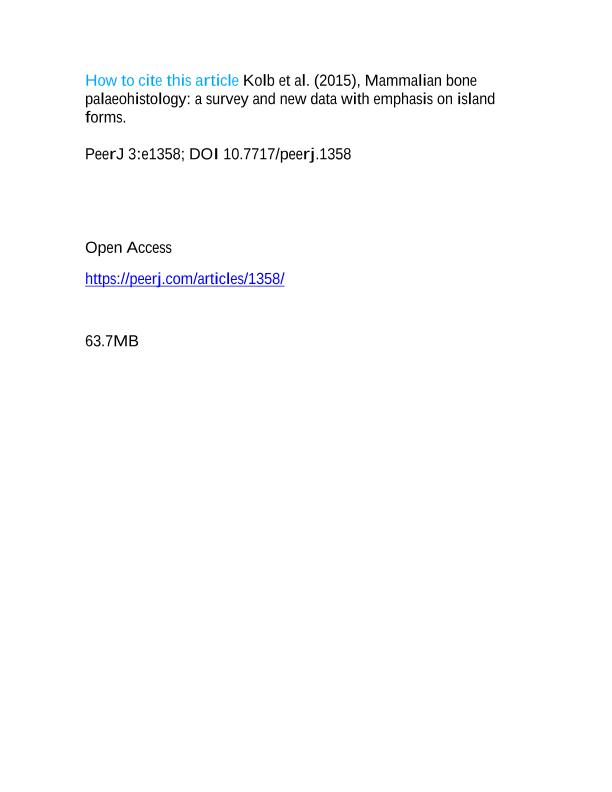Mostrar el registro sencillo del ítem
dc.contributor.author
Kolb, Christian
dc.contributor.author
Scheyer, Torsten M.
dc.contributor.author
Veitschegger, Kristof
dc.contributor.author
Forasiepi, Analia Marta

dc.contributor.author
Amson, Eli
dc.contributor.author
Van der Geer, A.
dc.contributor.author
Van den Hoek Ostende, Lars
dc.contributor.author
Hayashi, Shoi
dc.contributor.author
Sanchez Villagra Marcelo R.
dc.date.available
2019-02-12T22:31:48Z
dc.date.issued
2015-10
dc.identifier.citation
Kolb, Christian; Scheyer, Torsten M.; Veitschegger, Kristof; Forasiepi, Analia Marta; Amson, Eli; et al.; Mammalian bone palaeohistology: A survey and new data with emphasis on island forms; PeerJ Inc.; PeerJ; 2015; 10; 10-2015; 1-44
dc.identifier.issn
2167-8359
dc.identifier.uri
http://hdl.handle.net/11336/70029
dc.description.abstract
The interest in mammalian palaeohistology has increased dramatically in the last two decades. Starting in 1849 via descriptive approaches, it has been demonstrated that bone tissue and vascularisation types correlate with several biological variables such as ontogenetic stage, growth rate, and ecology. Mammalian bone displays a large variety of bone tissues and vascularisation patterns reaching from lamellar or parallel-fibred to fibrolamellar or woven-fibred bone, depending on taxon and individual age. Here we systematically review the knowledge and methods on cynodont and mammalian bone microstructure as well as palaeohistology and discuss potential future research fields and techniques. We present new data on the bone microstructure of two extant marsupial species and of several extinct continental and island placental mammals. Extant marsupials display mainly parallel-fibred primary bone with radial and oblique but mainly longitudinal vascular canals. Three juvenile specimens of the dwarf island hippopotamid Hippopotamus minor from the Late Pleistocene of Cyprus show reticular to plexiform fibrolamellar bone. The island murid Mikrotia magna from the Late Miocene of Gargano, Italy displays parallelfibred primary bone with reticular vascularisation and strong remodelling in the middle part of the cortex. Leithia sp., the dormouse from the Pleistocene of Sicily, is characterised by a primary bone cortex consisting of lamellar bone and a high amount of compact coarse cancellous bone. The bone cortex of the fossil continental lagomorph Prolagus oeningensis and three fossil species of insular Prolagus displays mainly parallel-fibred primary bone and reticular, radial as well as longitudinal vascularisation. Typical for large mammals, secondary bone in the giant rhinocerotoid Paraceratherium sp. fromthe LateOligocene of Turkey is represented by denseHaversian bone. The skeletochronological features of Sinomegaceros yabei, a large-sized deer from the Pleistocene of Japan closely related to Megaloceros, indicate a high growth rate. These examples and the synthesis of existing data show the potential of bone microstructure to reveal essential information on life history evolution. The bone tissue and the skeletochronological data of the sampled island species suggest the presence of various modes of bone histological modification and mammalian life history evolution on islands to depend on factors of island evolution such as island size, distance frommainland, climate, phylogeny, and time of evolution.
dc.format
application/pdf
dc.language.iso
eng
dc.publisher
PeerJ Inc.
dc.rights
info:eu-repo/semantics/openAccess
dc.rights.uri
https://creativecommons.org/licenses/by-nc-sa/2.5/ar/
dc.subject
Bone Tissue
dc.subject
Hippopotamus Minor
dc.subject
Island Evolution
dc.subject
Leithia
dc.subject
Mammals
dc.subject
Mikrotia
dc.subject
Palaeohistology
dc.subject
Paraceratherium
dc.subject
Prolagus
dc.subject
Sinomegaceros
dc.subject.classification
Meteorología y Ciencias Atmosféricas

dc.subject.classification
Ciencias de la Tierra y relacionadas con el Medio Ambiente

dc.subject.classification
CIENCIAS NATURALES Y EXACTAS

dc.title
Mammalian bone palaeohistology: A survey and new data with emphasis on island forms
dc.type
info:eu-repo/semantics/article
dc.type
info:ar-repo/semantics/artículo
dc.type
info:eu-repo/semantics/publishedVersion
dc.date.updated
2019-02-11T13:48:36Z
dc.journal.volume
2015
dc.journal.number
10
dc.journal.pagination
1-44
dc.journal.pais
Estados Unidos

dc.journal.ciudad
San Francisco
dc.description.fil
Fil: Kolb, Christian. Universitat Zurich; Suiza
dc.description.fil
Fil: Scheyer, Torsten M.. Universitat Zurich; Suiza
dc.description.fil
Fil: Veitschegger, Kristof. Universitat Zurich; Suiza
dc.description.fil
Fil: Forasiepi, Analia Marta. Consejo Nacional de Investigaciones Científicas y Técnicas. Centro Científico Tecnológico Conicet - Mendoza. Instituto Argentino de Nivología, Glaciología y Ciencias Ambientales. Provincia de Mendoza. Instituto Argentino de Nivología, Glaciología y Ciencias Ambientales. Universidad Nacional de Cuyo. Instituto Argentino de Nivología, Glaciología y Ciencias Ambientales; Argentina
dc.description.fil
Fil: Amson, Eli. Universitat Zurich; Suiza
dc.description.fil
Fil: Van der Geer, A.. Naturalis Biodiversity Center; Países Bajos. University of Athens; Grecia
dc.description.fil
Fil: Van den Hoek Ostende, Lars. Naturalis Biodiversity Center; Países Bajos
dc.description.fil
Fil: Hayashi, Shoi. Osaka Museum of Natural History; Japón
dc.description.fil
Fil: Sanchez Villagra Marcelo R.. Universitat Zurich; Suiza
dc.journal.title
PeerJ
dc.relation.alternativeid
info:eu-repo/semantics/altIdentifier/doi/https://dx.doi.org/10.7717/peerj.1358
dc.relation.alternativeid
info:eu-repo/semantics/altIdentifier/url/https://peerj.com/articles/1358
Archivos asociados
